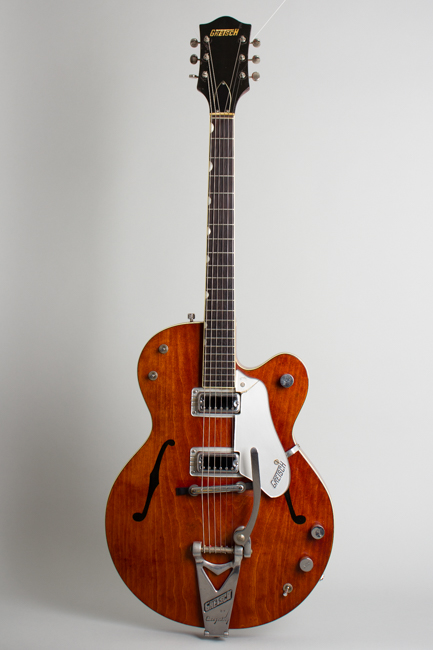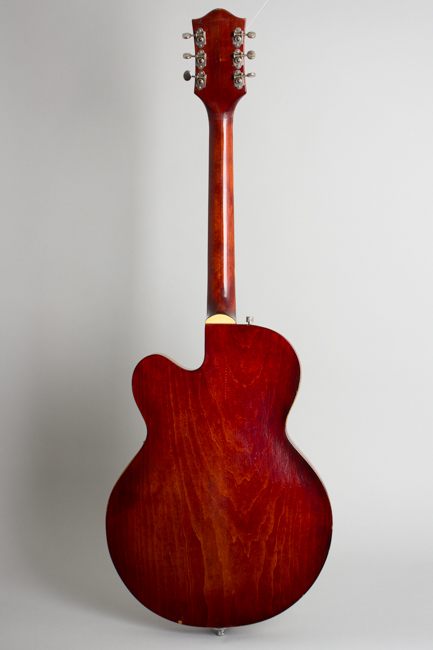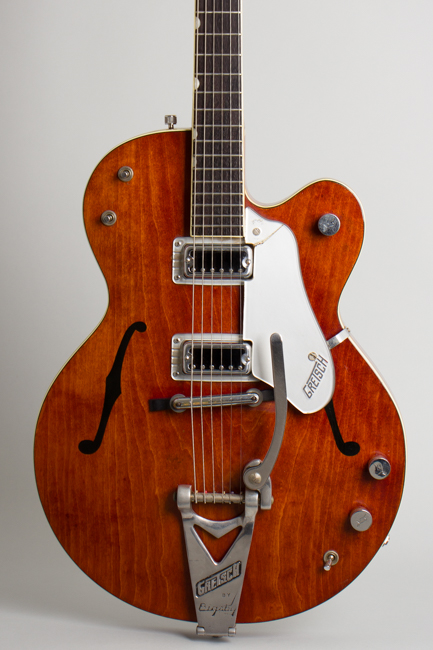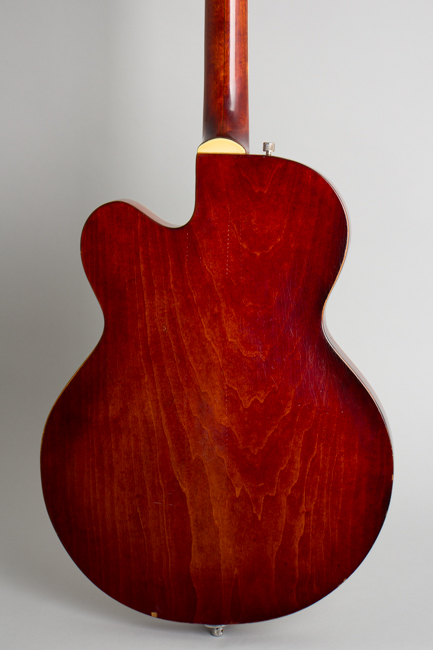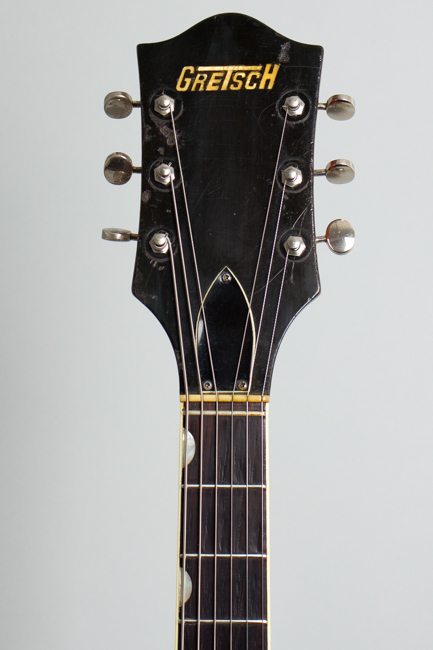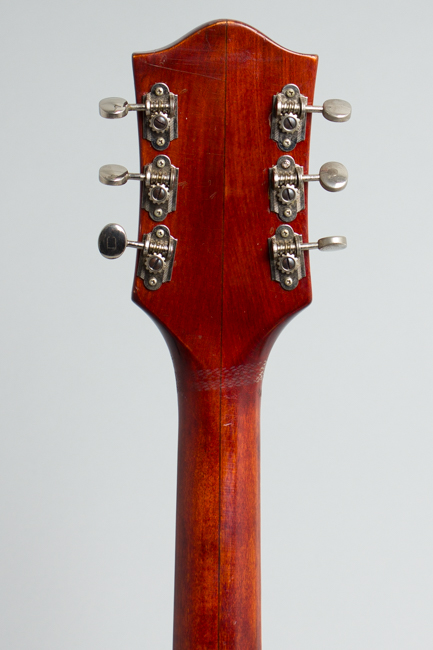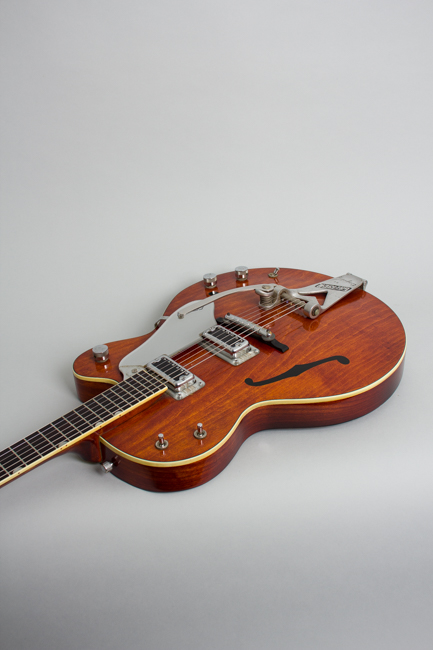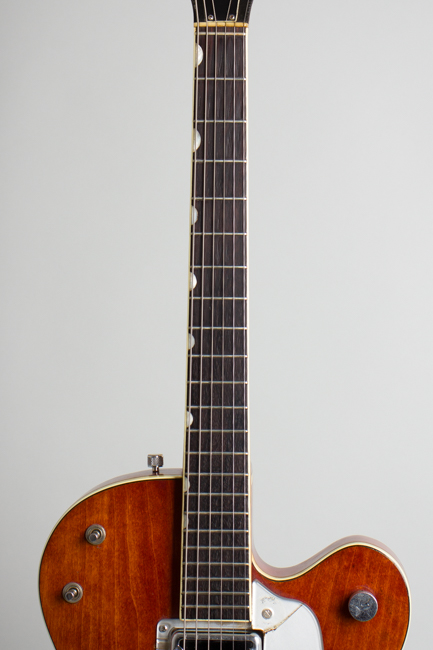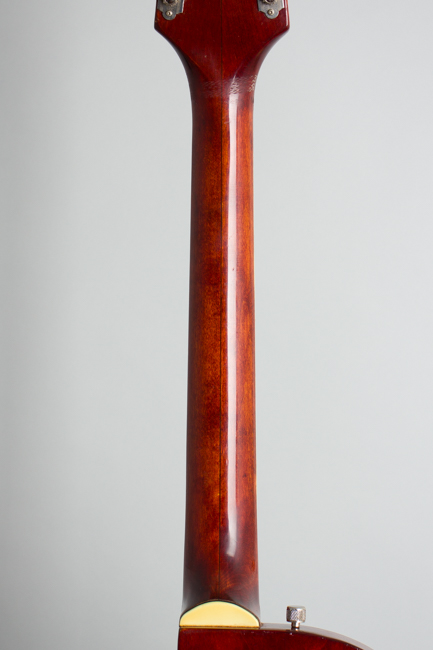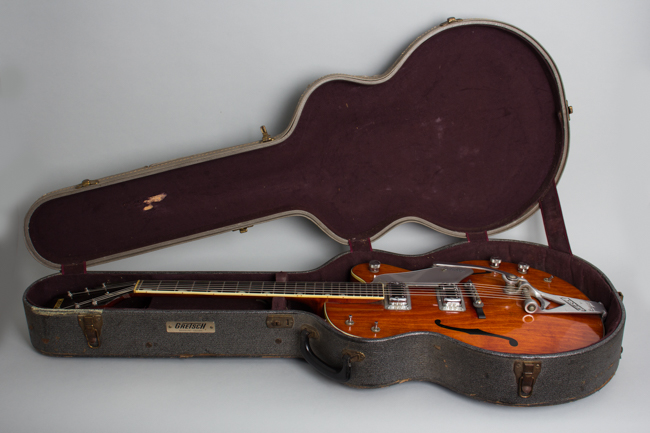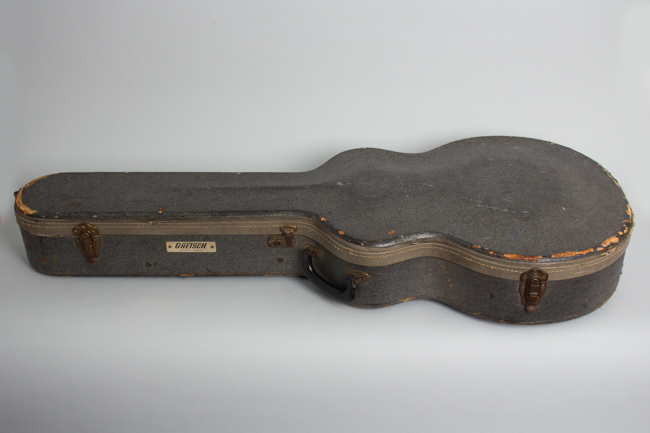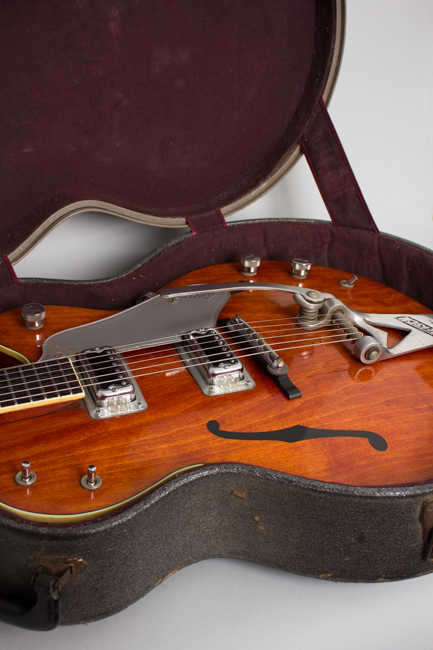Gretsch Chet Atkins Tennessean PX 6119 Thinline Hollow Body Electric Guitar (1961)
Gretsch Chet Atkins Tennessean PX 6119 Model Thinline Hollow Body Electric Guitar (1961), made in Brooklyn, NY, serial # 44767, brown lacquer finish, laminated maple body and neck, ebony fingerboard, original hard shell case.
This is a somewhat worn-in but generally nice example of an early first-year closed "Electrotone" body/2 pickup 6119 Tennessean, one of Gretsch's classic 1960s models. Although the least expensive instrument in the Chet Atkins line, the Tennessean was still a relatively upscale guitar by company standards with a "Gretsch by Bigsby" vibrato and two of the then-new Hi-Lo'tron pickups. It cost the not inconsiderable sum of $350.00 in 1961-2, the year it replaced the earlier full hollow body single-pickup 6119. Despite this it eventually became a best seller, one of the more popular guitars of the era with both professionals and teen garage band players. This one dates to the turn of 1961-2 and represents one of the first few batches of this then-new model.
The top of the laminated maple body is single bound, the back unbound. The guitar is finished in a medium dark mahogany stain overall, something Chet himself much preferred to the "gaudy" orange of his original signature model, the 6120. The laminated maple neck has a bound rosewood fingerboard with a zero fret (another Atkins requirement) and the half-moon "Neo-Classic" inlay pattern Gretsch used almost exclusively at the time.
This example features the early "unbound" stenciled-on "f-holes" which are hard to see on the dark finished body, no doubt why a white border was added to them within a year or so. Early Tennesseans also have openback Waverly tuners rather than the Van Gents used later, no Atkins markings on the pickguard and no headstock plaque. The 6119 remained the only single-cutaway guitar in the Atkins line, the Country Gentleman and 6120 becoming double-cutaways at the time. It also offers a somewhat brighter tone than those Filter'Tron equipped models thanks to the single coil HiLo'Tron pickups, coupled with the solid metal bar bridge.
This particular guitar has some wear and minor restoration but shows no binding issues and a very good neck angle, both often sore points of this model. As 1960s Gretsches go this first generation Electrotone 6119 is a relatively rare instrument, as Tennesseans were built in far larger numbers from 1964-66 and those are far more common today. Production of all Gretsch guitars and particularly the Tennessean went way up in the Beatle-saturated world of 1964-67, and the company's quality control team was often overwhelmed.
Many 1960s artists made extensive use of this popular model, including George Harrison (notably in the film "HELP!" and the 1965 Beatle tours) and David Crosby of The Byrds. Gerry Marsden (Gerry and the Pacemakers) is usually seen with an early Tennessean exactly like this one, and the Animals' Hilton Valentine used one exclusively in the band's earlier recordings, including the iconic "House of the Rising Sun". This is simply a classic 1960s Gretsch with a peerless "Beat Group" pedigree!
Overall length is 42 1/2 in. (108 cm.), 15 3/4 in. (40 cm.) wide at lower bout, and 2 in. (5.1 cm.) deep. Scale length is 24 3/4 in. (629 mm.).
This guitar remains in mostly original condition overall, showing some general wear and tear but none of the dreaded Gretsch binding rot that plagues many of their vintage instruments these days. The finish overall has checking, dings, dents and scrapes but no large areas of wear through the lacquer; the area under the bridge has some typical scuff marks. The back has a large but shallow "strap burn" running up the center, and there is a mark around the base of the headstock from a strap yoke once affixed there. The headstock face has the heaviest wear with some larger dings and chips and pressure rings remaining from non-original tuners once fitted. The guitar is now equipped with correct period chrome Waverly openback pegs just as it had originally.
The rest of the hardware on the guitar is all original with some light wear. The early-style original back-painted clear plastic pickguard has a noticeable crack behind the forward mounting screw, solidly but visibly repaired. There are a couple of small cracks on the corners of the plastic pickup rings, again a very common condition.
The original narrow frets have been crowned fairly low but remain quite playable, though smaller than a modern standard. The neck angle has a good break for the strings off the Bigsby and is nice and straight making this is one of the solider and better made Tennesseans we have had, having been sold well before ramp up for the "Beatle boom" that left Gretsch struggling to fill orders. Overall this is a nice playing early "Beat Group" era Gretsch, complete with the original HSC which is worn but still solid and functional. Overall Very Good + Condition.
This is a somewhat worn-in but generally nice example of an early first-year closed "Electrotone" body/2 pickup 6119 Tennessean, one of Gretsch's classic 1960s models. Although the least expensive instrument in the Chet Atkins line, the Tennessean was still a relatively upscale guitar by company standards with a "Gretsch by Bigsby" vibrato and two of the then-new Hi-Lo'tron pickups. It cost the not inconsiderable sum of $350.00 in 1961-2, the year it replaced the earlier full hollow body single-pickup 6119. Despite this it eventually became a best seller, one of the more popular guitars of the era with both professionals and teen garage band players. This one dates to the turn of 1961-2 and represents one of the first few batches of this then-new model.
The top of the laminated maple body is single bound, the back unbound. The guitar is finished in a medium dark mahogany stain overall, something Chet himself much preferred to the "gaudy" orange of his original signature model, the 6120. The laminated maple neck has a bound rosewood fingerboard with a zero fret (another Atkins requirement) and the half-moon "Neo-Classic" inlay pattern Gretsch used almost exclusively at the time.
This example features the early "unbound" stenciled-on "f-holes" which are hard to see on the dark finished body, no doubt why a white border was added to them within a year or so. Early Tennesseans also have openback Waverly tuners rather than the Van Gents used later, no Atkins markings on the pickguard and no headstock plaque. The 6119 remained the only single-cutaway guitar in the Atkins line, the Country Gentleman and 6120 becoming double-cutaways at the time. It also offers a somewhat brighter tone than those Filter'Tron equipped models thanks to the single coil HiLo'Tron pickups, coupled with the solid metal bar bridge.
This particular guitar has some wear and minor restoration but shows no binding issues and a very good neck angle, both often sore points of this model. As 1960s Gretsches go this first generation Electrotone 6119 is a relatively rare instrument, as Tennesseans were built in far larger numbers from 1964-66 and those are far more common today. Production of all Gretsch guitars and particularly the Tennessean went way up in the Beatle-saturated world of 1964-67, and the company's quality control team was often overwhelmed.
Many 1960s artists made extensive use of this popular model, including George Harrison (notably in the film "HELP!" and the 1965 Beatle tours) and David Crosby of The Byrds. Gerry Marsden (Gerry and the Pacemakers) is usually seen with an early Tennessean exactly like this one, and the Animals' Hilton Valentine used one exclusively in the band's earlier recordings, including the iconic "House of the Rising Sun". This is simply a classic 1960s Gretsch with a peerless "Beat Group" pedigree!
Overall length is 42 1/2 in. (108 cm.), 15 3/4 in. (40 cm.) wide at lower bout, and 2 in. (5.1 cm.) deep. Scale length is 24 3/4 in. (629 mm.).
This guitar remains in mostly original condition overall, showing some general wear and tear but none of the dreaded Gretsch binding rot that plagues many of their vintage instruments these days. The finish overall has checking, dings, dents and scrapes but no large areas of wear through the lacquer; the area under the bridge has some typical scuff marks. The back has a large but shallow "strap burn" running up the center, and there is a mark around the base of the headstock from a strap yoke once affixed there. The headstock face has the heaviest wear with some larger dings and chips and pressure rings remaining from non-original tuners once fitted. The guitar is now equipped with correct period chrome Waverly openback pegs just as it had originally.
The rest of the hardware on the guitar is all original with some light wear. The early-style original back-painted clear plastic pickguard has a noticeable crack behind the forward mounting screw, solidly but visibly repaired. There are a couple of small cracks on the corners of the plastic pickup rings, again a very common condition.
The original narrow frets have been crowned fairly low but remain quite playable, though smaller than a modern standard. The neck angle has a good break for the strings off the Bigsby and is nice and straight making this is one of the solider and better made Tennesseans we have had, having been sold well before ramp up for the "Beatle boom" that left Gretsch struggling to fill orders. Overall this is a nice playing early "Beat Group" era Gretsch, complete with the original HSC which is worn but still solid and functional. Overall Very Good + Condition.
